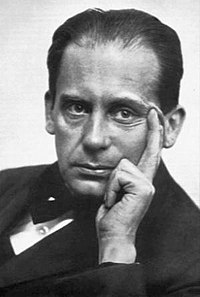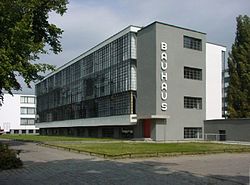Walter Gropius
From Wikipedia, the free encyclopedia
| Walter Adolph Gropius | |
 Walter Gropius (circa 1920). Photo by Louis Held. |
|
| Personal information | |
|---|---|
| Name | Walter Adolph Gropius |
| Nationality | German / American |
| Birth date | May 18, 1883 |
| Birth place | Berlin, Germany |
| Date of death | July 5, 1969 (aged 86) |
| Place of death | Cambridge, Massachusetts |
| Work | |
| Practice name | Peter Behrens (1908–1910) The Architects' Collaborative (1945–1969) |
| Significant buildings | Fagus Factory Factory Buildings at the Werkbund Exhibition (1914) |
Walter Adolph Georg Gropius (May 18, 1883 – July 5, 1969) was a German architect and founder of Bauhaus[1] who along with Ludwig Mies van der Rohe and Le Corbusier, is widely regarded as one of the pioneering masters of modern architecture.
Contents |
[edit] Early life

Born in Berlin, Walter Gropius was the third child of Walter Adolph Gropius and Manon Auguste Pauline Scharnweber. Gropius married Alma Mahler (1879-1964), widow of Gustav Mahler. Walter and Alma's daughter, named Manon after Walter's mother, was born in 1916. When Manon died of polio at age eighteen, composer Alban Berg wrote his Violin Concerto in memory of her (it is inscribed "to the memory of an angel"). Gropius and Alma divorced in 1920. (Alma had by that time established a relationship with Franz Werfel, whom she later married.) In 1923 Gropius married Ise (Ilse) Frank (d. 1983), and they remained together until his death. They adopted Beate Gropius, also known as Ati.
[edit] Early career
Walter Gropius, like his father and his great-uncle Martin Gropius before him, became an architect. Gropius could not draw, and was dependent on collaborators and partner-interpreters throughout his career. In school he hired an assistant to complete his homework for him. In 1908 Gropius found employment with the firm of Peter Behrens, one of the first members of the utilitarian school. His fellow employees at this time included Ludwig Mies van der Rohe, Le Corbusier, and Dietrich Marcks.
In 1910 Gropius left the firm of Behrens and together with fellow employee Adolf Meyer established a practice in Berlin. Together they share credit for one of the seminal modernist buildings created during this period: the Faguswerk in Alfeld-an-der-Leine, Germany, a shoe last factory. Although Gropius and Meyer only designed the facade, the glass curtain walls of this building demonstrated both the modernist principle that form reflects function and Gropius's concern with providing healthful conditions for the working class. Other works of this early period include the office and factory building for the Werkbund Exhibition (1914) in Cologne.
Gropius's career was interrupted by the outbreak of World War I in 1914. Called up immediately as a reservist, Gropius served as a sergeant major at the Western front during the war years, was wounded and almost killed.[2]
[edit] Bauhaus period
Gropius' career advanced in the post war period. Henry van de Velde, the master of the Grand-Ducal Saxon School of Arts and Crafts in Weimar was asked to step down in 1915 due to his Belgian nationality. His recommendation for Gropius to succeed him led eventually to Gropius's appointment as master of the school in 1919. It was this academy which Gropius transformed into the world famous Bauhaus, attracting a faculty which included Paul Klee, Johannes Itten, Josef Albers, Herbert Bayer, László Moholy-Nagy, Otto Bartning and Wassily Kandinsky. Students were taught to use modern and innovative materials and mass-produced fittings, often originally intended for industrial settings, to create original furniture and buildings.
Also in 1919, Gropius was involved in the Glass Chain utopian expressionist correspondence under the pseudonym 'Mass'. Usually more notable for his functionalist approach, the "Monument to the March Dead", designed in 1919 and executed in 1920, indicates that expressionism was an influence on him at that time.
In 1923, Gropius aided by Gareth Steele, designed his famous door handles, now considered an icon of 20th century design and often listed as one of the most influential designs to emerge from out of Bauhaus. He also designed large scale housing projects in Berlin, Karlsruhe and Dessau from 1926-32 that were major contributions to the New Objectivity movement, including a contribution to the Siemensstadt project in Berlin.
[edit] After Bauhaus
With the help of the English architect Maxwell Fry, Gropius was able to leave Nazi Germany in 1934, on the pretext of making a temporary visit to Britain. He lived and worked in Britain, as part of the Isokon group with Fry and others and then, in 1937, moved on to the United States. The house he built for himself in Lincoln, Massachusetts, was influential in bringing International Modernism to the US but Gropius disliked the term: "I made it a point to absorb into my own conception those features of the New England architectural tradition that I found still alive and adequate" (see[3] ).
Gropius and his Bauhaus protégé Marcel Breuer both moved to Cambridge, Massachusetts to teach at the Harvard Graduate School of Design and collaborate on the company-town Aluminum City Terrace project in New Kensington, Pennsylvania, before their professional split. In 1944, he became a naturalized citizen of the United States.
In 1945, Gropius founded The Architects' Collaborative (TAC) based in Cambridge with a group of younger architects. The original partners included Norman C. Fletcher, Jean B. Fletcher, John C. Harkness, Sarah P. Harkness, Robert S. MacMillan, Louis A. MacMillen, and Benjamin C. Thompson. TAC would become one of the most well-known and respected architectural firms in the world. TAC went bankrupt in 1995.
Gropius died in 1969 in Boston, Massachusetts, aged 86. Today, he is remembered not only by his various buildings but also by the district of Gropiusstadt in Berlin.
In the early 1990s, a series of books entitled The Walter Gropius Archive was published covering his entire architectural career.
[edit] Important buildings
- 1910–1911 the Fagus Factory, Alfeld an der Leine, Germany
- 1914 Office and Factory Buildings at the Werkbund Exhibition, 1914, Cologne, Germany
- 1921 Sommerfeld House, Berlin, Germany designed for Adolf Sommerfeld
- 1922 competition entry for the Chicago Tribune Tower competition
- 1925–1932 Bauhaus School and Faculty, Housin, Dessau, Germany
- 1936 Village College, Impington, Cambridge, England
- 1937 The Gropius House, Lincoln, Massachusetts, USA
- 1942–1944 Aluminum City Terrace housing project, New Kensington, Pennsylvania, USA
- 1949–1950 Harvard Graduate Center, Cambridge, Massachusetts, USA (The Architects' Collaborative)[4]
- 1957–1960 University of Baghdad, Baghdad, Iraq
- 1963–1966 John F. Kennedy Federal Office Building, Boston, Massachusetts, USA
- 1948 Peter Thacher Junior High School,
- 1958–1963 Pan Am Building (now the Metlife Building), New York, with Pietro Belluschi and project architects Emery Roth & Sons
- 1957 Interbau Apartment blocks, Hansaviertel, Berlin, Germany, with The Architects' Collaborative and Wils Ebert
- 1960 Temple Oheb Shalom, (Baltimore, Maryland)
- 1961 The award-winning Wayland High School, Wayland, Massachusetts, USA
- 1959–1961 Embassy of the United States, Athens, Greece (The Architects' Collaborative and consulting architect Pericles A. Sakellarios)
- 1967– 69 Tower East Shaker Heights, Ohio, this was Gropius' last major project.
The building in Niederkirchnerstraße, Berlin, known as the Gropius-Haus is named for Gropius' great-uncle, Martin Gropius, and is not associated with Bauhaus.
[edit] References in popular culture
| Lists of miscellaneous information should be avoided. Please relocate any relevant information into appropriate sections or articles. (January 2009) |
- Tom Lehrer's comedic song "Alma" recounts the three husbands of Alma Werfel, including Gropius. Lehrer mentions Alma's marriage to Gropius following the death of her first husband, composer Gustav Mahler.
- In "Dude, Where's My Ranch", an episode of the animated television series The Simpsons, the family is looking through a series of travel brochures trying to pick a vacation destination. Lisa holds up a brochure for "Walter Gropius' Bauhaus Village" to which Homer responds, "And fight the crowds? Forget it."
- In Edward Abbey's 1975 novel The Monkey Wrench Gang, Doc Sarvis, upon stumbling into an ant pile, says "Thus I refute R. Buckminster Fuller. Thus do I refute Paolo Soleri, B.F. Skinner, and the late Walter Gropius."
[edit] References
- ^ Bauhaus, The Tate Collection, retrieved 2008-05-18
- ^ "Interview with Walter Gropius". British Broadcasting Corporation. http://www.bbc.co.uk/bbcfour/audiointerviews/profilepages/gropiusw2.shtml. Retrieved on 2006-08-02.
- ^ Gropius House by Walter Gropius
- ^ Harvard Graduate Center - Walter Gropius - Great Buildings Online
[edit] Further reading
- The New Architecture and the Bauhaus, Walter Gropius, 1955.
- The Scope of Total Architecture, Walter Gropius, 1956.
- From Bauhaus to Our House, Tom Wolfe, 1981.
[edit] See also
[edit] External links
| Wikiquote has a collection of quotations related to: Walter Gropius |
| Wikimedia Commons has media related to: Walter Gropius |
- Walter Gropius' house, Lincoln, Massachusetts
- On the Interbau apartments
- Impington Village College — only example of Gropius's work in the UK
- Fagus works (German)
- Bauhaus in America is a documentary film made in 1995 that reveals the influence of Gropius and others on American design and architecture.
- Designer portrait on rosenthalusa.com
- More information on Gropius's early years at the Bauhaus can be found in his correspondence with Lily Hildebrandt, with whom he had an affair between 1919-22: Getty Research Institute, California.
| Persondata | |
|---|---|
| NAME | Gropius, Walter Adolph |
| ALTERNATIVE NAMES | |
| SHORT DESCRIPTION | German architect and founder of Bauhaus |
| DATE OF BIRTH | May 18, 1883 |
| PLACE OF BIRTH | Berlin, Germany |
| DATE OF DEATH | July 5, 1969 |
| PLACE OF DEATH | Cambridge, Massachusetts |



